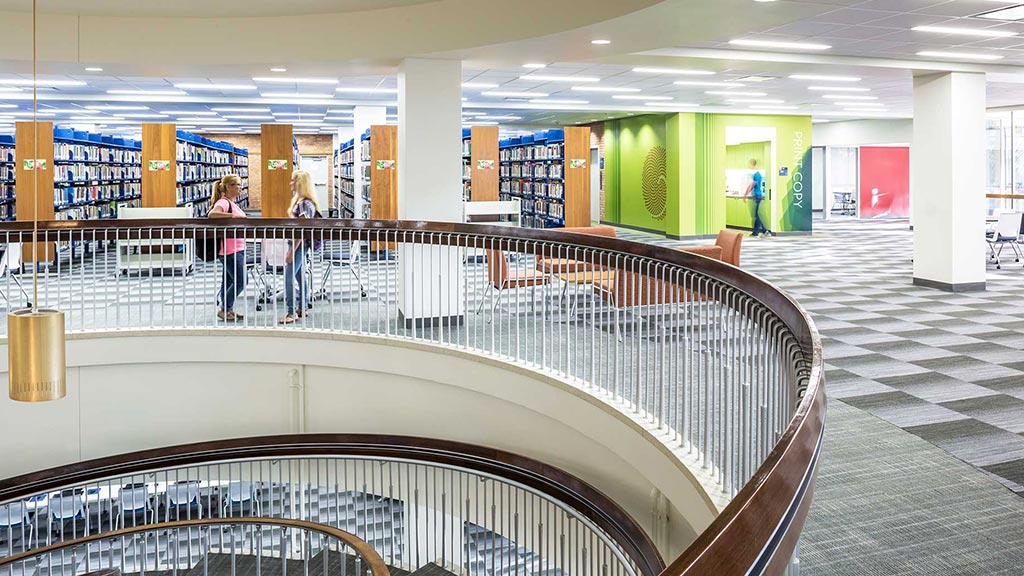How do students envision the present and future academic library?
Libraries are for Studying
What We Did
We conducted an online survey among a random sample of 1,200+ college students across the US to understand the study habits and preferences of today’s students, how the library is supporting those needs, and how they see the library evolving in the future. This builds on prior Gensler survey research documenting overall student behavior and campus needs, observational research of libraries to document usage patterns and uncover opportunities for improvement, and a series of library leader roundtables. Our goal was to capture the student voice and to understand the library spaces, services, and experiences that best support learning and the evolution of the library.
The Context
Libraries serve a critical role in the on-campus experiences of today’s student—as they have for generations. Often iconic buildings in prominent campus locations, a college’s library system expresses a commitment to academics and a promise to parents that they’re sending their students to a quality institution. But the value goes far beyond the symbolic. Libraries continue to serve highly practical campus roles as well: as places to study, to find quiet, and to access resources—even if those resources are as much pixels as paper.
As colleges seek to keep their campuses relevant in the wake of a changing educational landscape, libraries often take center stage. The library, for many, conjures images of books, stacks and card catalogs—physical objects that seem outdated as resources and collections shift toward the digital realm. Library buildings, as a result, have become a key focus as institutions seek to update campus facilities to align with new students and study habits.
But in discussions ostensibly focused on supporting students’ ability to study and learn, a direct representation of the student voice is often absent. As a result, assumptions about the shifting needs and behaviors of today’s student—based on their status as “digital natives” and an assumed shift toward digital tools, multitasking, and “always-on” communication—often prove misplaced.
The Results
Despite a continued narrative around the perceived irrelevance of the library in an age of digital resources, students see the library as an essential part of their college experience, and see this role continuing as they look to the future. While students report the library as a preferred space for both individual and group activities, their conception of the ideal library skews toward the solitary. Their top-ranked library qualities center around space to complete focused, individual work, and when asked what resources are most important to libraries today, “quiet space for students” ranks first. When asked about the future, the rising importance of digital resources and connectivity becomes clear, while quiet space shows its continued importance.
This conception fits with how students are spending their time—they spend on average 13.5 hours/week studying or working alone on campus, compared to only 4.3 hours/week engaged in collaborative or group work—and aligns with findings from prior Gensler research. Individual work dominates the library experience as well: when asked what activities they visit the library for, studying/working alone tops the list, followed by group work and access to digital resources. Students’ preference for individual work is also supported by the behavior of the highest performers—“A” students report more time studying alone than average, though this added study time appears to be outside the library.
What This Means
Focus on pragmatic, individual student needs. Students seek out the library for both focused and collaborative work, and to access digital and print resources. Prioritize areas in support of these activities to best support student need.
Don’t sacrifice quiet in pursuit of collaboration. Libraries must deliver spaces to support both individual and group work, but these goals can be in conflict if not managed correctly. Consider delineating group-focused activities and spaces from areas devoted to quiet work to maintain an appropriate atmosphere and noise-level.
Integrate technology as a companion to analog tools. Students appear to be reliant on both analog and technological tools to complete their work—both must be supported for space to be effective. When asked what resources will be most important to the library of the future, the responses by students of quiet space, digital resources, and integrated technology top the list.
What’s Next?
Students express a clear preference for completing individual work at the library, but it’s not the only place they’re working alone—nor is it the only place they go to collaborate or access digital resources. Yet something both physical and symbolic about library space appeals to students seeking to study and connect. As libraries consider their future, expanding their culture and reaching beyond their walls, both physically and virtually, is an opportunity to make an even greater impact.
Smart, flexible approaches to technology are also a key opportunity—and challenge. Integrated technology and digital access will continue to grow in importance, but how to best integrate tech differs by institution and student profile. An expanding suite of personal technology and a BYOD (Bring Your Own Device) culture means many facilities may prioritize accommodating students’ personal devices over continually purchasing and integrating the newest technologies.
Learn More
Team
Mark Thaler, Christine Barber, Tim Pittman
Year Completed
2015
Comments or ideas for further questions we should investigate?
